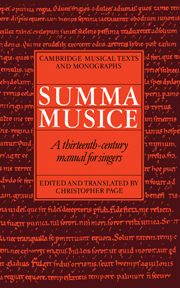Book contents
- Frontmatter
- Contents
- Preface
- Abbreviations
- Intervallic notation in the Summa musice
- 1 The authorship of the treatise
- 2 The scope and character of the treatise
- 3 Sources and metrics
- 4 The text and the edition
- Summa musice: The translation
- Summa musice: The text
- Textual notes and rejected readings
- Sources, parallels, citations and allusions
- Appendix
- Bibliography
- Annotated catalogue of chants
- Index auctorum
2 - The scope and character of the treatise
Published online by Cambridge University Press: 14 January 2010
- Frontmatter
- Contents
- Preface
- Abbreviations
- Intervallic notation in the Summa musice
- 1 The authorship of the treatise
- 2 The scope and character of the treatise
- 3 Sources and metrics
- 4 The text and the edition
- Summa musice: The translation
- Summa musice: The text
- Textual notes and rejected readings
- Sources, parallels, citations and allusions
- Appendix
- Bibliography
- Annotated catalogue of chants
- Index auctorum
Summary
The Summa musice is a practical manual for teaching boys to sing from plainchant notation. Like the Disticha Catonis, a famous collection of schoolroom maxims which is quoted almost verbatim in the first lines of the work, the Summa musice is a schoolbook. We can also read it as a literary work designed to kindle a flame of devotion to Christian history and to the writings of the Ancients: Horace, Ovid, Virgil and more besides. The literary ambitions of the Summa musice are plain enough in the authors' decision to construct their treatise from passages of prose alternating with versified and highly figurative statements of the same information (of which more below), but it is also part of the literary nature of the Summa musice that it is such a verbal work. There is not a single table or diagram of the sort to be found in other treatises on music theory; there is only one musical example and the authors refer to their reluctance to mix musical notation and prose (1935–6).
Perseus and Petrus have also pruned away most of the thorny terms and topics of chant theory. They never use the Greek string-terminology which gives many treatises an alarming appearance (‘proslambanomenos’, ‘hypate meson’, and so on) nor the accepted terms for mathematical relations and proportions like ‘sesquitertia’ and ‘superbipartiens’. They never broach the kind of speculative topics that pleased the fancy of some theorists (a comparison between neumes and the metrical feet of Classical prosody, for instance), and they avoid certain questions, such as the division of the semitone, which lead so many other theorists into technicalities.
- Type
- Chapter
- Information
- Summa MusiceA Thirteenth-Century Manual for Singers, pp. 13 - 32Publisher: Cambridge University PressPrint publication year: 1991



